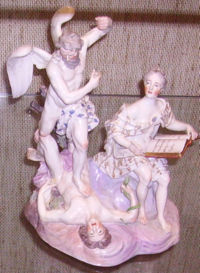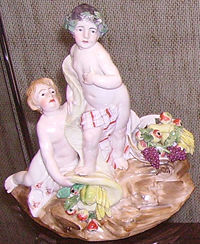
Frankenthal Porcelain Factory
Encyclopedia

Porcelain
Porcelain is a ceramic material made by heating raw materials, generally including clay in the form of kaolin, in a kiln to temperatures between and...
manufacturers of Germany and operated in Frankenthal
Frankenthal
Frankenthal is a town in southwestern Germany, in the state of Rhineland-Palatinate.- History :Frankenthal was first mentioned in 772. In 1119 an Augustinian monastery was built here, the ruins of which — known, after the founder, as the Erkenbertruine — still stand today in the town...
in the Rhineland-Palatinate
Rhineland-Palatinate
Rhineland-Palatinate is one of the 16 states of the Federal Republic of Germany. It has an area of and about four million inhabitants. The capital is Mainz. English speakers also commonly refer to the state by its German name, Rheinland-Pfalz ....
between 1755 and 1799.
History
The porcelain factory in Frankenthal was established in 1755 by the Hannong family, who had previously manufactured porcelain in StrasbourgStrasbourg
Strasbourg is the capital and principal city of the Alsace region in eastern France and is the official seat of the European Parliament. Located close to the border with Germany, it is the capital of the Bas-Rhin département. The city and the region of Alsace are historically German-speaking,...
until Louis XVI established a state monopoly on porcelain in favour of the Sèvres factory
Manufacture nationale de Sèvres
The manufacture nationale de Sèvres is a Frit porcelain porcelain tendre factory at Sèvres, France. Formerly a royal, then an imperial factory, the facility is now run by the Ministry of Culture.-Brief history:...
and closed down all others. Karl Hannong transferred his business to an empty barracks in Frankenthal and staffed it with his Strasbourg workforce, under privilege from Elector Carl Theodor of Bavaria
Karl Theodor
Karl Theodor may refer to:* Charles Theodore, Elector of Bavaria , Prince-Elector of Palatine and of Bavaria* Karl Theodor Anton Maria von Dalberg , Freiherr of Dalberg and Archbishop-Elector of Mainz...
, who visited the factory himself in the following year, once production was well under way. In 1757 additional craftsmen were hired from Meissen
Meissen
Meissen is a town of approximately 30,000 about northwest of Dresden on both banks of the Elbe river in the Free State of Saxony, in eastern Germany. Meissen is the home of Meissen porcelain, the Albrechtsburg castle, the Gothic Meissen Cathedral and the Meissen Frauenkirche...
and in 1759 Hannong was able to open a shop in Strasbourg.
However, in 1760 Karl Hannong died and the business became the property of his two sons Joseph Adam Hannong and Peter Anton Hannong, who fell out over the "arcanum" (the formula of the paste). Their disagreements had a damaging effect on the business and by 1761 they had borrowed so much from the Elector that it was impossible for them to repay it. In 1762 therefore the Elector bought the factory from the Hannongs for 40,804 guilders, plus another 10,00 for the arcanum, and installed his own officials to manage it.

Aachen
Aachen has historically been a spa town in North Rhine-Westphalia, Germany. Aachen was a favoured residence of Charlemagne, and the place of coronation of the Kings of Germany. Geographically, Aachen is the westernmost town of Germany, located along its borders with Belgium and the Netherlands, ...
, Basle, Frankfurt am Main, Livorno
Livorno
Livorno , traditionally Leghorn , is a port city on the Tyrrhenian Sea on the western edge of Tuscany, Italy. It is the capital of the Province of Livorno, having a population of approximately 160,000 residents in 2009.- History :...
, Mainz
Mainz
Mainz under the Holy Roman Empire, and previously was a Roman fort city which commanded the west bank of the Rhine and formed part of the northernmost frontier of the Roman Empire...
, Munich
Munich
Munich The city's motto is "" . Before 2006, it was "Weltstadt mit Herz" . Its native name, , is derived from the Old High German Munichen, meaning "by the monks' place". The city's name derives from the monks of the Benedictine order who founded the city; hence the monk depicted on the city's coat...
and Nancy.
The Napoleonic Wars
Napoleonic Wars
The Napoleonic Wars were a series of wars declared against Napoleon's French Empire by opposing coalitions that ran from 1803 to 1815. As a continuation of the wars sparked by the French Revolution of 1789, they revolutionised European armies and played out on an unprecedented scale, mainly due to...
brought an end to the business. Frankenthal was occupied by the French
France
The French Republic , The French Republic , The French Republic , (commonly known as France , is a unitary semi-presidential republic in Western Europe with several overseas territories and islands located on other continents and in the Indian, Pacific, and Atlantic oceans. Metropolitan France...
, who closed the porcelain factory down in 1799.
The Frankenthal factory was in operation for only 44 years (run for 7 years by the Hannongs, and for 37 by the electoral administration) and is thus the shortest-lived of the major German
Germany
Germany , officially the Federal Republic of Germany , is a federal parliamentary republic in Europe. The country consists of 16 states while the capital and largest city is Berlin. Germany covers an area of 357,021 km2 and has a largely temperate seasonal climate...
porcelain manufacturers. Collections of Frankenthal porcelain may be seen, among other places, in the Reiss Engelhorn Museums in Mannheim
Mannheim
Mannheim is a city in southwestern Germany. With about 315,000 inhabitants, Mannheim is the second-largest city in the Bundesland of Baden-Württemberg, following the capital city of Stuttgart....
, the Kurpfälzisches Museum
Kurpfälzisches Museum
The Kurpfälzisches Museum is a museum of art and archaeology in Heidelberg, Germany. It is located in the Palais Morass. It was founded in the late 1870s, when the city of Heidelberg purchased the private collection of the artist and art historian Charles de...
in Heidelberg
Heidelberg
-Early history:Between 600,000 and 200,000 years ago, "Heidelberg Man" died at nearby Mauer. His jaw bone was discovered in 1907; with scientific dating, his remains were determined to be the earliest evidence of human life in Europe. In the 5th century BC, a Celtic fortress of refuge and place of...
, the Historisches Museum der Pfalz in Speyer
Speyer
Speyer is a city of Rhineland-Palatinate, Germany with approximately 50,000 inhabitants. Located beside the river Rhine, Speyer is 25 km south of Ludwigshafen and Mannheim. Founded by the Romans, it is one of Germany's oldest cities...
and the Bavarian National Museum
Bavarian National Museum
The Bavarian National Museum in Munich is one of the most important cultural history museums in Europe.-Building and History:...
in Munich
Munich
Munich The city's motto is "" . Before 2006, it was "Weltstadt mit Herz" . Its native name, , is derived from the Old High German Munichen, meaning "by the monks' place". The city's name derives from the monks of the Benedictine order who founded the city; hence the monk depicted on the city's coat...
. Works of the brothers Paul and Johann Hannong are displayed in the Musée des Arts décoratifs, Strasbourg
Musée des Arts décoratifs, Strasbourg
The Musée des Arts décoratifs of the city of Strasbourg, France, is found on the ground floor of the Palais Rohan, the former city palace of the Prince-Bishops from the Rohan family. One half of the museum is made up of the magnificent chambers in the late baroque, Rococo and Empire styles...
and in the Musée du pain d'épice in Gertwiller
Gertwiller
Gertwiller is a French commune in the Bas-Rhin department in Alsace in north-eastern France.Positioned in the heart of the Alsace wine growing region, Gertwiller specialises in the manufacture of pain d'épices, a traditional sweet spicey confection not dissimilar from ginger bread...
.

